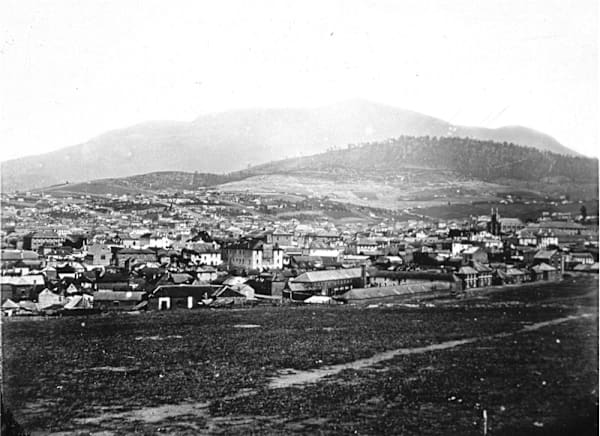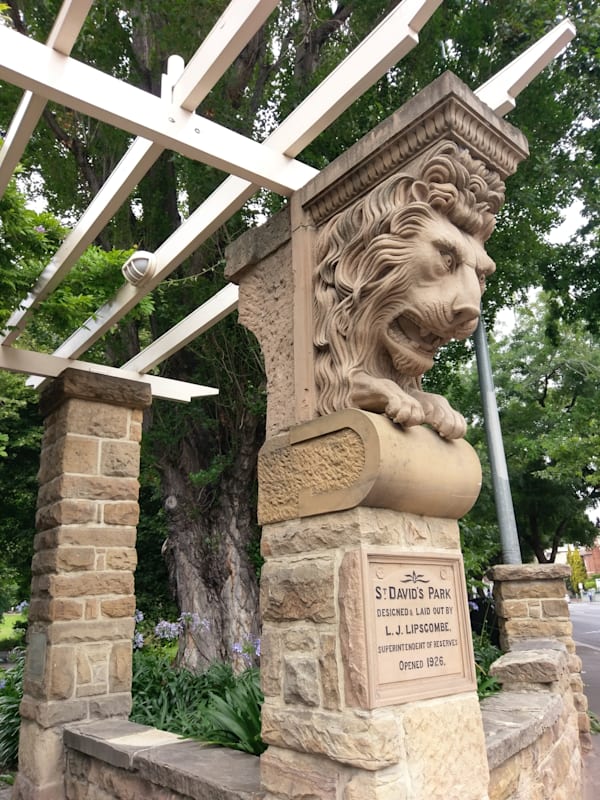A man was captured crossing a city street. His feet straddle a tram line and one arm extends in the swing of a brisk walk. A tramcar is disappearing behind him while a truck accelerates from the empty space before him. Surrounding advertisements tell their own stories. Both sides of the street implore the patriotic to Buy War Savings Certificates. A purveyor of “Kodak supplies” beckons the eye to compel the beholder to think of photography. The streetscape boasts a familiar and distant church spire pointing heavenward beyond buildings both familiar and unfamiliar, electrical wires, motorcars, more people, and forgotten daily concerns.
This scene is now the spot where malls meet. A bus mall in the foreground abuts a pedestrian mall in the middle view before the street continues, unfazed, still leading to and from the suburbs. The trams are gone and so are two of the corner buildings, but the earlier, war-time view of Hobart’s Elizabeth Street and Collins Street intersection reveals more than a moment in time. It contains a small proof of the human power to transcend it.
If they had turned right at the photograph and followed Collins Street for a few blocks, our war-time cameraperson would have been too late to see St Peter’s Hall. Constructed in 1855, the Tasmanian newspaper described it as “for Temperance and other moral and social meetings which can have a tendency to promote the best interests and welfare of the people at large – as well as for sacred purposes”.

Located in Collins Street near its interception of Campbell Street and across from the rightly-famous Theatre Royal, St Peter’s Hall was something of a Catholic clubhouse. It was a place to hold Grand Fancy Bazaars and High Tea Parties, such social events helping bring financial absolution from the debt incurred in having it built.
Henry Hunter, the famous colonial architect, was one of the builders responsible for erecting St Peter’s rock upon rock. Not yet famous nor fully established, he cut some of his neo-gothic teeth through building the little stone hall with its lancet windows and side buttresses. For the better part of half a century, St Peter’s Hall stood as a place of education, entertainment and edification. It was a major part of Hobart’s social and cultural landscape. Until, that is, the site was sold to a timber merchant.
Fortunately, a distant view of St Peter’s infancy survives in a photograph of the city taken a few years after the hall opened.
It is identifiable by its location, three slithers of an end window, and its church-like shape and dimensions. Because so many early photographers delighted in snapping the city cowering beneath Mount Wellington, the cityscape was repeatedly captured in film in the 19th century from much the same viewpoint. This photographical canon makes analysing the shifting architectural history of this city uniquely easy. Certain buildings help date photographs, and photographs in turn help date buildings.

In Hobart the truth of history seems tucked between these images left by an ever-quibbling but strangely-matched couple.
I learned this dating technique while writing the history of St Mary’s Cathedral, a structure usually distant in the city skyline, whose story was often recorded in fuzzy blurs beyond the lens’ capacities. Peering at sequential images of Hobart, I could make out the cathedral’s chancel and tower going up, and then the tower coming down, and then an extended nave being added without the tower – a grey photo essay of Henry Hunter’s apprenticeship in the arts of balancing architectural glory and gravity. After St Peter’s Hall, this was one of his biggest projects, and certainly one of the longest-lasting, despite the whole tower hiccup.
. . .
St Mary’s still embraces its original flawed core, and is perhaps more beautiful for that organic history. It has become an architectural parable that grace can come through imperfection. But it is also a frequent destination for visitors to the city, drawn to admire the architectural layers, and a pilgrimage site for enthusiasts of the neo-gothic and its great patron, Augustus Welby Northmore Pugin, and his colonial acolytes like Hunter.
Pugin is perhaps most famous for his work on London’s Palace of Westminster, but he was also a close friend of Hobart’s first Catholic bishop, Robert William Willson, and thereby became an artisanal benefactor to this remote colonial diocese. Pugin sent Willson to Hobart with a range of neo-gothic goodies, including exemplars and designs for tombstones, priests’ chasubles, chalices and baptismal fonts.
Tasmania is thereby the richest source of Pugin paraphernalia outside of Europe.
Typical of this strand of Tasmania’s unique heritage is a medieval-era font, now situated within St Mary’s Cathedral. It most likely arrived from Europe as one of Pugin’s gifts for Willson. As ecclesiastical fashions shifted down the centuries old fonts often got replaced by newer models, were discarded or neglected until forgotten, and became animal troughs or garden ornaments. Until, that is, they were rediscovered amid the enthusiasm for the medieval past that marked the gothic revival movement. Such items were often then restored to their original use, albeit sometimes after a long sea journey. This was likely one such find, a tactile link between continents and eras.
The wider Catholic complex of buildings around St Mary’s Cathedral also includes other relics, most notably an old Tasmanian one. At the corner of Harrington and Brisbane Streets is a colonial building, ironically erected after Australia’s federation. When St Peter’s Hall was pulled down in 1903, its stones were carried several blocks uphill and re-laid on a different corner. It is the oldest building on the site, but also one of the newest. Like its neighbour, St Mary’s, additions crept around it, including some faintly art-deco extensions, its story made more interesting for the accretions of time and happenstance.
This is surely the difference between heritage and historic – one is valuable and loved, the other is just old.

. . .
Not all of Hobart’s old treasures were so lucky, although the two buildings that once sat a few corners up Collins Street from St Peter’s partly survived their original situations. Both were younger than St Peter’s, designed by the then-famous colonial architect Henry Hunter, and each was demolished sometime after a man crossed a street and a war was won.
In early 1884, The Mercury applauded these new “City Improvements” at the corner of Elizabeth and Collins streets. “The offices of the Australian Mutual Provident Society are now completed,” it noted, “with the exception of the statuary for the corner.”
This was the building towards which our silhouetted friend was crossing some years later, and which in 1884 had been under construction for a few years. An earlier description of the project characterised elements of the building being “somewhat of a Gothic type, but very freely treated”.
As buildings generally do, it had years of minor renovations and amendments, and one major round of extensions to modernise and extend it in 1913. It had a few more decades of service before it was demolished to make way for what became in 1968 Hobart’s tallest building, the new corporate tower lording it over the city and seeming to give the finger to the mountain that still dwarfed it.
Several good photographs of this lost Australian Mutual Provident Fund Building survive. One, taken from in front of its lost companion diagonally opposite, shows it sporting stylish, new, carved entranceways added in those renovations done just before a war started. It also had an additional story, but that is another story, and did not last terribly long anyway. But a tangential story began when the kindly corporate masters of 1968 donated one of the carved entranceways to the Royal Tasmanian Botanical Gardens. The former entranceway can now be found as a greenery-surrounded arch, celebrating an anniversary for which it was never intended, but managing its new duties with impassive decorum.

Henry Hunter’s other 1884 improvement upon that much-photographed city corner was the Bank of Van Diemen’s Land Building. The Mercury described this having been “revealed in all its chaste and striking architectural glory” after it was finally undressed of its scaffolding. “It is,” the paper enthused, “without doubt, a magnificent building, a credit alike to the designer, the builders, and the owners, and an adornment in city buildings of which Hobart may well be proud. There are few structures in the Australian colonies approaching it in perfection.”
Until, that is, the reportedly perfect building was pulled down.
Yet care was taken to allow two stone survivors to escape this destructive progress. A pair of ornamental lions once guarded the main entrance to the apparently pretty bank, and they now adorn the entranceway to St David’s Park. Being a former cemetery, the small pride now presumably guards a different kind of vault, although they clearly did a poor job of protecting their building.
Nick Brodie describes himself as a professional history nerd. He has a doctorate in late medieval vagrancy law, is a leading expert on the history of poor boxes, and is the author of acclaimed popular histories Kin: A Real People's History of Our Nation and 1787: The Lost Chapters of Australia's Beginnings. His latest book is The Vandemonian War: The Secret History of Britain's Tasmanian Invasion, which uses a wealth of new archival material to re-write Australia's most infamous colonial war.











